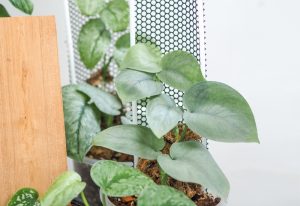Pothos plants are beloved by many indoor gardeners for their hardiness and lush foliage. Two varieties that often get confused are Emerald Pothos and Jade Pothos. In this article, we’ll uncover the key differences between these two pothos plants to help you choose the perfect one for your space.
Emerald and Jade Pothos Basics
Botanical Classification
Emerald and Jade Pothos are popular houseplants and belong to the Epipremnum genus, with the scientific name Epipremnum aureum. It’s crucial to recognize them as distinct from Philodendrons, which are often confused with Pothos species due to their similar appearance.
Physical Appearance

Although both Emerald and Jade Pothos have attractive glossy, leathery leaves, they display different variegation patterns. Emerald Pothos features dark and light green patterns, making them visually appealing. On the other hand, Jade Pothos has solid green foliage and is easily distinguished by its bright green leaves peppered with white and cream splatters and speckles. Occasionally, Jade Pothos may even exhibit gray coloring.
Growth Patterns

These tropical indoor plants are ideal for hanging baskets or potted growth, as they are easy to grow indoors with minimal care. Both varieties are vigorous growers, but Jade Pothos is known to be slightly more drought-resistant than its Emerald counterpart.
When it comes to propagation, Jade Pothos is particularly excellent for this purpose. It can be propagated from cuttings that are around 10 inches (25 centimeters) in length, with visible nodes and a few leaves. You can root these cuttings in water until new growth appears, then transplant them into nutrient-rich soil for continued growth.
Caring for Emerald and Jade Pothos
Light Requirements
Emerald and Jade Pothos thrive in bright, indirect light but can also tolerate low light conditions. They are adaptable plants and can survive in various light settings. However, ensure they’re not exposed to direct sunlight for an extended period, as this can cause leaf burn.
Watering Essentials
Both varieties appreciate regular watering, but they don’t like sitting in water. Wait until the soil is partly dry before watering again. Overwatering can lead to root rot, which can be detrimental to the plant’s health. Pay close attention to the moisture level in the soil to avoid over or underwatering.
Ideal Soil and Fertilizer
Emerald and Jade Pothos prefer moist potting soil with excellent drainage. A well-draining mix helps prevent overwatering and root rot. Adding some perlite or orchid bark to the mix can improve drainage and aeration.
Fertilizing these plants is not mandatory, but providing some nutrients can help them grow more vigorously. Use a balanced liquid fertilizer every 6 to 8 weeks during the growing season. Be careful not to over-fertilize, as this can cause the leaves to yellow and potentially damage the roots.
Remember to follow a proper care routine with the right amount of light, water, soil, and fertilization to keep your Emerald and Jade Pothos healthy and thriving.
Common Issues and Solutions
Pest Control
One of the most common issues encountered when caring for both emerald and jade pothos is pest infestations. Some pests that may attack these plants include spider mites, aphids, and mealybugs. To prevent and treat pest infestations, regularly inspect your plants, keep the environment clean, and hose down the leaves with water. If infestations persist, consider using insecticidal soaps or neem oil to protect your plants.
Disease Management
Disease is another concern when caring for emerald and jade pothos plants. Root rot, for example, often occurs due to overwatering and can lead to yellow leaves, wilted growth, and even death of the plant. To avoid root rot, ensure proper drainage and avoid overwatering. In case of a fungal infection, you might need to use a fungicide to treat the issue.
Overwatering and Underwatering
Both overwatering and underwatering can cause problems in emerald and jade pothos plants. Browning tips on the leaves often indicate underwatering, while yellow leaves are typically a sign of overwatering. Make sure to water your pothos when the top few inches of soil dry out, and avoid letting the plant sit in standing water.
To address underwatering, increase the frequency of watering, while making sure the soil does not become waterlogged. For overwatering issues, cut back on the amount and frequency of watering, ensuring the soil has a chance to dry out before the next watering.
Managing Humidity
Emerald and jade pothos plants may also suffer from browning tips due to low humidity. These tropical plants thrive in higher humidity levels, so try to maintain an environment with adequate air moisture. To increase humidity around your plants, you can use a humidifier, place a tray of water with pebbles near the plant, or regularly mist the leaves with water.
By following these guidelines and keeping a close eye on your emerald and jade pothos plants, you can ensure their health and longevity. Remember to remain observant for any signs of distress, and take the necessary steps to address the issues as they arise.
Propagation Techniques
Stem Cuttings
Emerald and Jade pothos can both be propagated using stem cuttings. First, select a healthy stem with at least three leaves on each plant. Use a sterile, sharp knife or shears to take the cutting from the Jade pothos, and repeat the same process for the Emerald pothos.
Next, prepare a potting mixture that is half peat moss and half perlite or sand to plant the cuttings. Before planting, remove the first leaf above the cut ends of the stems and dip the cut end in rooting hormone, ensuring the first set of root nodes is covered for both plant varieties. Afterward, plant the cuttings into the potting mixture, and keep the soil evenly moist for the first one to two weeks to help the roots acclimate to the soil. Place the freshly potted plants in a location with bright, indirect light.
Division Method
Another method for propagating Emerald and Jade pothos is through the division method. To do this, follow these steps:
- Gently remove the plant from its current pot, taking care not to damage the root system.
- Carefully separate the plant into two or more sections, with at least one healthy stem in each section. Make sure each section has a good amount of roots attached as well.
- Prepare new pots with well-draining soil mixtures, ideally a blend of peat moss, perlite, or sand.
- Plant each divided section into a new pot, firmly compacting the soil around the roots to provide support.
After following these steps, be sure to water the freshly repotted plants thoroughly and place them in a location with bright, indirect light. Maintain a consistent watering schedule to ensure the divisions successfully establish themselves in their new environment.
By using these techniques, you can successfully propagate both Emerald and Jade pothos in your home, allowing you to expand your collection or share these beautiful plants with friends and family.
Emerald vs Jade: Choosing the Right Plant
When comparing the Emerald Pothos and Jade Pothos, it’s essential to consider the differences in appearance and the growing conditions each plant prefers. Both plants belong to the same family, but their unique characteristics make them stand out from each other.
The Emerald Pothos showcases lighter green leaves with blotches of darker green variegation, typically in the middle of the leaf. The colors often blend together, giving the plant a visually pleasing effect. On the other hand, the Jade Pothos has bright green leaves peppered with white and cream splatters and speckles, sometimes even appearing to have gray coloring.
When it comes to light requirements, both plants can tolerate various light conditions. However, the Jade Pothos can thrive in bright light and is also suitable for low light or shaded areas. This makes it an excellent choice for spaces like bathrooms or offices where light may be limited. The Emerald Pothos also grows well in different lighting situations but may display more vibrant colors when exposed to medium to bright indirect light.
In terms of humidity, the Jade Pothos is low-maintenance and doesn’t require high levels of moisture, making it an ideal choice for busy plant owners or in environments without access to high humidity. The Emerald Pothos is also adaptable to a range of humidity levels, but might appreciate occasional misting for optimum growth.
Finally, when considering growth rate and propagation, both plants are relatively easy to care for and reproduce. The Jade Pothos is excellent when it comes to propagating from cuttings, requiring just a strong stem with visible nodes and a few leaves. You can root the cutting in water and transplant it to nutrient-rich soil once new growth appears. The Emerald Pothos also responds well to propagation methods, making it easy to grow new plants from healthy cuttings.
As you decide between the Emerald and Jade Pothos, consider their physical differences, light requirements, and humidity preferences. Remember that each plant has its unique charm and can be an eye-catching addition to your indoor garden.
Related Video

My name is Daniel Elrod, and I have been houseplant love ever since I was 17. I love how much joy they bring to any room in the home. I’ve always been amazed at how a few pots of flowing leaves can turn a drab and sterile office into an inviting place where people love to work at.

















































































































































































































































